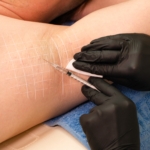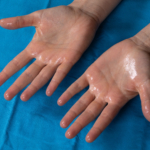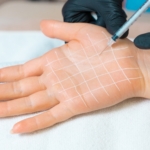Hyperhidrosis is excessive sweating that may occur over the entire body or only in certain parts, most commonly the underarms, palms of the hands and soles of the feet. It tends to start when the patient is a teenager with excessive sweating in certain areas – like under arm sweating and hands, although it can effect the whole body. This condition is not life threatening but it can be embarrassing, be tricky to manage day to day, significantly effect confidence and cause psychological suffering for the patient. It is not a condition that is spoken about widely but it is not as uncommon as you may think.
Fast Facts to know about hyperhidrosis
- There is often no known cause
- Effects about 3% of the population
- There are many treatment options
What causes hyperhidrosis? This condition is caused by over activity of the nerves that carry messages to the affected sweat glands. These nerves are part of the ‘sympathetic’ nervous system, which means that they are ‘involuntary’ or not under our conscious control.
- Primary idiopathic hyperhidrosis – unknown cause. This is the most common type of hyperhidrosis
- Secondary hyperhidrosis – the patient sweats to much because of an underlying health condition like –
- most commonly – obesity, gout, menopause, a tumor or diabetes
What is the treatment for hyperhidrosis? Treatment may begin initially with trialling different antiperspirants which contain a low dose of metal salt. If this is not effective your doctor may test to assess you on a specific medication to reduce or stop excessive sweating. There is also the option of using a neurotoxin (commonly known as botox). This is a short term treatment which is done with a series of injections every 3-5 months. You may be referred, this is an appropriate treatment, to one of our vascular nurses who specialise in treating hyperhidrosis with Dysport. Both of our nurses work at Bloom, they offer a 20min consultation to discuss Dysport treatment and costs. Bloom is located in our 325 Willis Street building.
Is there a Surgical option? Yes. This surgical procedure known as Endoscopic Thoracic Sympathectomy (ETS). This is a minimally invasive procedure (it does not require a large incision or cut to be made) and involves interrupting the nerves that supply the sweat glands.
Fast facts about ETC
- It is performed by one of our vascular surgeons at a selected private hospital.
- This procedure is done under a general anesthetic
- It is minimally invasive – but all surgeries have risks and potential complications
Book a consultation with one of our vascular surgeons – Dr Lupe Taumeopeau or Mr JK (Kes) Wicks today. They will be happy to discuss the best treatment options for you or your family member. Contact us today.


